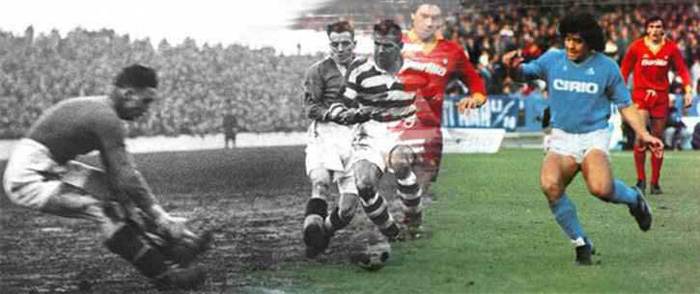How Has Soccer Changed Over Time?
Soccer has evolved significantly over time, experiencing changes in rules, technology, tactics, and global popularity. From its origins as a simple game played in ancient civilizations, soccer has transformed into a highly sophisticated and internationally renowned sport.
Today, the sport boasts a vast network of professional leagues, advanced training methods, and intense competition. These developments have not only influenced the way the game is played, but also how it is perceived culturally and economically. With billions of fans worldwide, soccer’s evolution has created a multi-billion dollar industry, with lucrative sponsorship deals, media coverage, and passionate fanbases.
As the sport continues to progress, it is likely that we will witness further changes and innovations that will shape its future.
Early Forms Of Soccer: A Historical Overview
Soccer, or football as it is known in most parts of the world, has a rich and fascinating history that spans centuries. The game has evolved significantly over time, shaped by various cultures, civilizations, and periods. In this section, we will explore some of the early forms of soccer and their historical significance.
Origins In Ancient China, Greece, And Rome
In ancient times, soccer-like games were played in different parts of the world, including ancient China, Greece, and Rome. These civilizations had their own versions of the game, which resembled modern soccer in some ways, while also having distinct variations.
In Ancient China, a game called “Cuju” was played as early as the Han Dynasty (206 BC – 220 AD). Cuju involved kicking a ball through a hole in a net, and it was often played for military training purposes. This early form of soccer emphasized footwork, precision, and teamwork.
In Greece, a game known as “Episkyros” was popular during the 5th and 4th centuries BC. It involved two teams trying to get the ball over the opponent’s boundary lines by any means necessary. Episkyros was played on a rectangular field, and players used both their feet and hands to control and pass the ball.
Similarly, in ancient Rome, a game called “Harpastum” was played. Harpastum involved two teams trying to control and pass a small ball, using techniques such as shoulder charging and tackling. It was a physically demanding game that required strength, agility, and strategic thinking.
Medieval And Renaissance Variations
During the medieval and Renaissance periods, variations of soccer continued to develop, particularly in Europe. These variations often had different rules and playing styles, reflecting the cultural and societal influences of the time.
One notable variation was called “Mob Football” or “Shrovetide Football,” which emerged in medieval England. In this game, hundreds of players from rival villages would participate in a chaotic and rough contest, trying to move an inflated pig’s bladder towards their respective goals. It was a highly popular and extremely violent game, often causing injuries and property damage.
Another variation, called “Calcio Storico,” emerged in Florence, Italy during the Renaissance. Calcio Storico was a combination of soccer, rugby, and wrestling, played between four teams representing different neighborhoods. The game involved kicking, wrestling, and even punches, making it a fiercely physical and intense sport.
Overall, the medieval and Renaissance periods witnessed a diversification of soccer-like games, each with its own unique characteristics and regional variations. These variations laid the foundation for the modern game of soccer, shaping its rules, strategies, and even its spirit of competition.

Credit: www.footballhistory.org
Transformation Of Soccer Rules: From Chaos To Structure
The world’s most popular sport, soccer, has evolved significantly over time. From its humble beginnings as a chaotic game played by different rules, it has gradually transformed into a structured sport with universal regulations. Understanding the historical journey of soccer rules helps us appreciate the level of organization and fairness we witness in the modern game. This section explores how soccer rules have been codified and standardized, starting with the pivotal role played by the Football Association.
Codification Of Rules By The Football Association
The codification of soccer rules by the Football Association (FA) in the mid-19th century resulted in a significant shift towards uniformity and consistency. Established in 1863, the FA sought to establish a single set of regulations that could be universally adopted. These rules, known as the Laws of the Game, brought structure and order to a sport that had previously been characterized by chaos.
Under the guidance of the FA, the Laws of the Game addressed various aspects of the sport, including player conduct, equipment, and gameplay. This codification allowed for greater understanding and synchronization among players, as well as providing a foundation for the further evolution of soccer rules.
The Influence Of Cambridge Rules And Sheffield Rules
Prior to the codification by the FA, regional variations of soccer rules were prevalent. However, two sets of rules, the Cambridge Rules and the Sheffield Rules, played crucial roles in shaping the future of the sport.
The Cambridge Rules, established in 1848 by members of the Cambridge University, were influential in laying the groundwork for the unified Laws of the Game. These rules introduced concepts like not using hands to touch the ball, a standardized field size, and a distinct notion of fair play – all of which formed the basis for subsequent advancements.
Soon after, the Sheffield Rules emerged in 1857 as a response to the Cambridge Rules. Developed by the Sheffield Football Club, these regulations had a profound regional impact. They introduced features such as corner kicks, goalkeepers, and free kicks. Although the Sheffield Rules differed from the Cambridge Rules, their influence was significant, leading to subsequent rule adaptations.
The Standardization Of Soccer Regulations
Over time, the need for standardization became increasingly evident, as various leagues and associations began to embrace the sport. The efforts to harmonize soccer regulations gained traction, resulting in the consolidation of rules and practices.
Today, the International Football Association Board (IFAB) plays a crucial role in the standardization of soccer regulations. Comprised of the national football associations of England, Scotland, Wales, and Ireland, the IFAB is responsible for maintaining and refining the Laws of the Game. Through a consultative process, the IFAB evaluates proposed rule changes and ensures that the game remains fair, safe, and enjoyable for all participants.
The meticulous process of standardization has allowed for the worldwide adoption of soccer rules, enabling players and fans to share a common understanding and experience of the game, regardless of their geographical location.
| Time Period | Key Event |
|---|---|
| 1848 | Establishment of Cambridge Rules |
| 1857 | Introduction of Sheffield Rules |
| 1863 | Codification of soccer rules by the Football Association |
| 1886 | Formation of the International Football Association Board |
From the chaos of regional variations to the structure brought by the codification and standardization of soccer regulations, the transformation of the sport’s rules has been instrumental in its worldwide success. This pathway, carved by pioneers like the Football Association, the Cambridge Rules, and the Sheffield Rules, has allowed the beautiful game to transcend boundaries and create a shared passion for soccer across the globe.
Technological Advancements In Soccer: Innovations That Shaped The Game
Introduction Of Goal Nets And Field Markings
Over the years, soccer has experienced remarkable technological advancements that have completely transformed the game. From the humble beginnings of chaotic matches on grassy fields to highly synchronized gameplay on meticulously marked pitches, the innovations in soccer have significantly shaped the way the sport is played and enjoyed today. One of the most impactful advancements is the introduction of goal nets and field markings, which have revolutionized gameplay and brought a whole new level of accuracy and fairness to the game.
Before the introduction of goal nets, determining whether a goal was scored or not often led to disputes and controversies. Players and spectators depended solely on the referee’s judgment, which sometimes resulted in unfair decisions. However, with the introduction of goal nets, the outcome of a goal became clear-cut. The net provides a visual and auditory confirmation when the ball passes through it, leaving no room for speculation or argument.
In addition to goal nets, the establishment of standardized field markings has been crucial in bringing uniformity and structure to soccer. Previously, fields were marked haphazardly, and there were no official dimensions or guidelines. The lack of proper markings made it difficult for players to determine boundaries and for referees to enforce rules. However, as the sport gained popularity and professionalism emerged, the need for consistent field markings became evident. Today, soccer fields boast clearly defined perimeters, goal areas, penalty areas, and halfway lines, ensuring that players and officials have a clear understanding of the field’s boundaries and regulations.
Evolution Of Soccer Balls And Footwear
Another technological advancement that has greatly influenced soccer is the evolution of soccer balls and footwear. These two elements are integral to a player’s performance and have undergone significant innovations throughout history. The early days of soccer saw players using handmade balls covered in animal bladders and leather, making them unpredictable and cumbersome to play with. However, as technology advanced, soccer balls underwent several transformations.
Today, soccer balls are designed with precision and durability in mind. Made from synthetic materials like polyurethane or leather blends, modern soccer balls feature intricate panel designs that optimize aerodynamics and provide players with better control and accuracy. Additionally, advancements in manufacturing techniques allow for consistent weight and size, ensuring that each ball meets the same standards of playability.
Similarly, the development of specialized soccer footwear has significantly impacted the game. In the early years, players had limited options when it came to footwear, often relying on basic leather boots with metal studs. However, with advancements in materials and design, players now have access to a wide range of soccer cleats that cater to different playing styles and field conditions. Cleat designs feature improved traction, lightweight construction, and enhanced stability, enabling players to perform at their best in various scenarios.
Impact Of Video Assistant Referee (var) Technology
One of the most recent technological advancements in soccer is the implementation of video assistant referee (VAR) technology. VAR has been a game-changer, providing additional support to referees in making accurate and fair decisions. This technology utilizes video replays and advanced camera systems to review critical match incidents, including goals, penalties, red cards, and cases of mistaken identity.
The introduction of VAR has significantly reduced human errors and controversial decisions. Referees now have the opportunity to review close calls and make more informed judgments, ensuring fairness and minimizing the impact of incorrect decisions on the outcome of a match. While VAR has been met with some skepticism and debates regarding its implementation, it undeniably demonstrates the commitment of soccer authorities to embrace technological advancements in the pursuit of improving the game.
Changes In Tactics And Strategies: From Simplicity To Complexity
One of the most fascinating aspects of soccer’s evolution is the transformation of tactics and strategies used by teams on the field. From the early days of the sport when simplicity was key, teams have now embraced a complex and intricate approach to the game. This article will explore the various changes in tactics and strategies throughout soccer’s history, focusing on the evolution of playing formations, the development of pressing and counter-attacking tactics, and the influence of Total Football and tiki-taka styles.
Evolution Of Playing Formations
The evolution of playing formations in soccer has been a constant topic of conversation among coaches, players, and fans alike. Over the years, teams have experimented with different structures on the field to maximize their strengths, exploit their opponents’ weaknesses, and adapt to changing game dynamics.
In the early days of soccer, formations were relatively simple, with teams often employing a straightforward 2-3-5 or 2-3-2-3 setup. These formations placed emphasis on attacking and scoring goals, prioritizing the use of wingers and center-forwards to create opportunities in the opponent’s territory.
However, as the game progressed and defensive strategies became more sophisticated, the need for a more balanced formation arose. This led to the development of various systems, such as the 4-4-2, where two banks of four players were deployed to provide a solid defensive foundation while still allowing for attacking options.
Today, formations have become even more complex, with teams using tactics such as the 4-3-3, 4-2-3-1, and even the fluid 3-4-3. These formations allow for versatility and flexibility depending on the game situation, ensuring teams have optimal control over various areas of the field.
Development Of Pressing And Counter-attacking Tactics
Another notable change in soccer tactics over time is the development of pressing and counter-attacking strategies. These tactics aim to disrupt the opponent’s build-up play and quickly transition the game in favor of the team implementing them.
Historically, teams would often defend in a deep block and focus on maintaining a strong defensive line. However, as the game became faster and more dynamic, pressing became a key feature of modern soccer. High-intensity pressing involves players aggressively closing down opponents in their own half, forcing mistakes and turnovers.
Similarly, counter-attacking tactics have evolved to take advantage of defensive weaknesses when the opponent commits players forward. Instead of relying solely on a slow build-up play, teams now look to quickly transition from defense to attack, utilizing the speed and skill of their players to create scoring opportunities.
Influence Of Total Football And Tiki-taka Styles
The influence of certain playing styles on the evolution of soccer tactics cannot be overstated. Total Football, a style popularized by the Dutch in the 1970s, emphasized fluid movement on the field, with players interchanging positions seamlessly. This style demanded high levels of technical ability, intelligence, and positional understanding from every player.
Tiki-taka, on the other hand, is a possession-based playing style made famous by the Spanish national team and FC Barcelona. This approach focuses on short, quick passes and maintaining control of the ball for long periods, wearing down opponents and creating scoring opportunities through patient build-up play.
Both Total Football and tiki-taka have had a significant impact on soccer tactics, inspiring teams all over the world to adopt similar principles. The emphasis on positional play, intelligent movement, and fluid passing has become a hallmark of many successful modern-day teams.
The changes in tactics and strategies in soccer have been marked by a shift from simplicity to complexity. The evolution of playing formations, the development of pressing and counter-attacking tactics, and the influence of playing styles like Total Football and tiki-taka have all contributed to the game’s transformation. As soccer continues to evolve, it will be intriguing to see what new tactical innovations emerge.
Social And Cultural Impact: Soccer As A Global Phenomenon
Soccer, or football as it is known in many parts of the world, has undergone tremendous changes over time. Beyond being just a game, soccer has become a global phenomenon with far-reaching social and cultural impacts. In this article, we will explore three key aspects of soccer’s social and cultural impact: its increasing popularity and global reach, the impact of televised matches and media coverage, and its role in fostering social integration and national pride.
Increasing Popularity And Global Reach Of The Sport
One of the most noticeable changes in soccer over time is its exponential increase in popularity and global reach. From local competitions to international tournaments, the sport has captured the hearts of millions around the world. Today, soccer clubs have dedicated fan bases, both in their home countries and abroad. The sport has a universal appeal that transcends borders, cultures, and languages.
Soccer’s global reach can be attributed to several factors. Firstly, the globalization of the sport has led to the establishment of professional leagues in various countries, attracting top talents from different parts of the world. This influx of international players has helped raise the level of competition and attract a diverse audience.
Additionally, the advent of social media and digital platforms has made it easier for fans to connect with their favorite teams and players. Fans can now follow live updates, share their opinions, and engage in discussions with fellow enthusiasts from all corners of the globe. This level of connectivity has further contributed to soccer’s global popularity.
Impact Of Televised Matches And Media Coverage
Television has played a crucial role in the growth of soccer as a global phenomenon. The coverage of matches on television has allowed millions of people to watch their favorite teams in action, regardless of their geographical location. This accessibility has broadened the sport’s audience and increased its appeal beyond live spectators in stadiums.
Televised matches have also had a significant impact on the commercial aspect of soccer. With increased viewership, the sport has attracted larger sponsorship deals, advertising opportunities, and media rights agreements. These financial investments have transformed soccer into a multi-billion-dollar industry, with clubs and players commanding high salaries and transfer fees.
Soccer’s Role In Fostering Social Integration And National Pride
Soccer has proven to be more than just a game. It has become a powerful tool for fostering social integration and promoting national pride. The sport transcends social and cultural barriers, bringing people from diverse backgrounds together to support a common cause – their national team or favorite club.
In many countries, soccer has served as a unifying force, especially during major tournaments such as the FIFA World Cup or UEFA European Championship. These events create a sense of solidarity and camaraderie among fans, irrespective of their political or socio-economic differences. Soccer has the unique ability to unite people in celebration and bring a sense of pride to a nation.
Moreover, soccer has the potential to address social issues and promote positive change. It can serve as a platform for advocating equality, diversity, and inclusivity. Major soccer organizations and players have been influential in supporting charitable causes and raising awareness about pressing social issues. Through its immense popularity, soccer can drive positive social transformation.
Women’s Soccer Transformation: Breaking Barriers And Achieving Equality
Women’s soccer has come a long way over the years, breaking down barriers and achieving remarkable progress towards gender equality in the sport. The struggle for recognition and opportunities, milestones in women’s soccer history, and the ongoing commitment to gender equality have all played significant roles in shaping the landscape of women’s soccer today.
The Struggle For Recognition And Opportunities
For decades, women’s soccer faced an uphill battle for recognition and opportunities on par with their male counterparts. Overcoming societal norms and deeply entrenched gender biases, women fought tirelessly to prove their skills and passion for the game. Even as early as the 1920s, women faced discrimination and were banned from playing in many countries.
Despite the challenges, women’s soccer pioneers pushed forward, forming their own teams and leagues. In 1971, the Women’s United Soccer Association (WUSA) brought professional women’s soccer to the United States, creating a much-needed platform for the sport. These women demonstrated their unwavering determination and showcased their talents, slowly breaking down barriers and paving the way for future generations.
Milestones In Women’s Soccer History
The history of women’s soccer is marked by several key milestones that have shaped the sport’s transformation. One significant moment occurred in 1991 when the inaugural FIFA Women’s World Cup took place in China. This landmark event drew widespread attention and shattered the notion that women’s soccer was merely a sideshow.
Since then, the women’s game has continued to reach new heights. The Women’s World Cup has become a global spectacle, captivating fans worldwide. In 1999, the United States Women’s National Team (USWNT) won the tournament in front of a record-breaking crowd, gaining immense popularity and inspiring a new generation of female players.
Progress Towards Gender Equality In The Sport
Thanks to the relentless efforts of advocates and trailblazers, women’s soccer has made tremendous strides towards achieving gender equality. In recent years, we have witnessed increased investment, media coverage, and fan engagement in the women’s game.
More and more organizations are recognizing the value of women’s soccer and are actively working to close the gap between men’s and women’s football. FIFA, for instance, has implemented initiatives such as the FIFA Women’s Football Strategy, aimed at promoting gender equality and increasing opportunities for women in the sport.
Additionally, professional leagues around the world are taking significant steps to level the playing field. Equal pay has become a central topic of discussion, with players and organizations advocating for fair compensation for female athletes. This renewed focus on gender equality has brought about positive change, empowering women in soccer to reach their full potential and thrive on and off the field.
Women’s soccer has undergone a dynamic transformation, breaking barriers and achieving remarkable progress towards gender equality. The struggles faced by women in the sport have given rise to inspirational stories and milestones that have forever changed the landscape of women’s soccer. As more opportunities continue to be created, and the commitment to gender equality persists, we can look forward to a future where women’s soccer is celebrated and valued on an equal footing with men’s soccer.
Economy And Commercialization: Soccer Becomes Big Business
Over the years, soccer has evolved from being just a sport into a multi-billion dollar industry. The economy and commercialization of soccer have played a significant role in transforming the game into a global phenomenon. From the rise of sponsorships and endorsements to the astronomical player transfers and soaring wages, soccer has become one of the most lucrative industries in the world.
The Rise Of Sponsorships And Endorsements
Sponsorships and endorsements have become integral parts of modern soccer, with the game being intertwined with brands and commercial partnerships. From local businesses to multinational corporations, companies have recognized the immense potential of aligning their brand with popular soccer teams and players. This has led to lucrative sponsorship deals, where organizations gain exposure to millions of fans through stadium naming rights, jersey sponsorship, and other marketing avenues. As a result, the revenue generated from sponsorships and endorsements has skyrocketed, contributing to the financial growth of clubs and players alike.
Expensive Player Transfers And Soaring Wages
The world of soccer has witnessed an unprecedented surge in player transfers and wages in recent years. Clubs are now willing to shell out exorbitant sums of money to secure the services of top talents, driving up the transfer market to astronomical heights. With the influx of massive TV deals and the growing popularity of the sport, the financial power of clubs has surged, allowing them to spend lavishly on player acquisitions. Consequently, player wages have also shot up, with soccer stars earning staggering amounts of money, regularly making headlines for their astronomical salaries. This trend has widened the financial gap between the top-tier clubs and their competitors, giving rise to debates about the fairness and sustainability of such spending.
The Growth Of Soccer As A Lucrative Industry
Soccer has transformed into a lucrative industry, generating immense wealth for all stakeholders involved. The sheer global reach of the sport has attracted significant investment from various sources, ranging from media companies to individual owners. The growth of digital media platforms has further amplified the commercial potential of soccer, allowing clubs to tap into a worldwide fanbase and monetize their brand value. TV broadcasting rights, merchandising, ticket sales, and online streaming platforms have become significant revenue streams, ensuring the financial stability and growth of the industry as a whole.
| Changes in Soccer Economy and Commercialization | Impact |
|---|---|
| The rise of sponsorships and endorsements | Increase in revenue for clubs and players, increased exposure for brands |
| Expensive player transfers and soaring wages | Widened financial gap between clubs, debates on fairness and sustainability |
| The growth of soccer as a lucrative industry | Diversified revenue streams, financial stability for stakeholders |
As the economy and commercialization of soccer continue to evolve, the sport is expected to attract even more investment and attention from various sectors. With the digital landscape constantly evolving, the potential for further growth in sponsorships, endorsements, and revenue streams seems unlimited. However, it remains essential to strike a balance between the financial aspects and the integrity of the game, ensuring that soccer maintains its competitive spirit and continues to captivate fans around the world.
Future Trends: Envisioning The Next Chapter Of Soccer’s Evolution
Soccer, the beloved sport that has captured the hearts of millions around the globe, has come a long way since its humble beginnings. Over the years, it has evolved tremendously in terms of its rules, gameplay, and fan engagement. As we eagerly anticipate the future, there are several exciting trends that are poised to shape the next chapter of soccer’s evolution.
Technological Advancements And Their Potential Impact
The advancements in technology have not only revolutionized our daily lives but also have the potential to transform the world of soccer. From goal-line technology to virtual reality training, innovations in the field of technology are enhancing both the gameplay and the overall fan experience.
One significant technological advancement that has already made its mark in soccer is the implementation of video assistant referee (VAR) systems. This technology has brought a new level of accuracy and fairness to the game, ensuring that critical decisions are made with the help of video replays, leaving minimal room for error.
Looking ahead, we can expect even more exciting advancements in technology. For instance, advancements in wearable technology could provide real-time data on players’ physical condition and performance, enabling coaches to make informed decisions about substitutions and training regimes.
Furthermore, the integration of augmented reality (AR) and virtual reality (VR) technologies could revolutionize the way fans engage with the game. Imagine being able to experience the thrill of a live match from the comfort of your own home, immersing yourself in every moment as if you were there in person.
The Role Of Data Analytics And Artificial Intelligence
Data analytics and artificial intelligence (AI) are rapidly changing the way soccer is played, coached, and analyzed. With the abundance of data available today, teams can now make strategic decisions based on comprehensive statistics and insights.
Through the utilization of AI algorithms, teams can analyze vast amounts of data to identify patterns and trends that may have gone unnoticed by humans alone. This newfound knowledge can lead to innovative playing strategies, player recruitment techniques, and even injury prevention methods.
Moreover, data analytics and AI can enhance the overall fan experience. Fans can now access detailed statistics and analysis, enriching their understanding of the game and providing a deeper connection to their favorite teams and players.
Anticipated Changes In Rules, Gameplay, And Fan Engagement
The future of soccer holds promising changes in the rules, gameplay, and fan engagement. Football governing bodies are constantly exploring ways to optimize the game and make it more exciting, fair, and inclusive.
One possible change that has been a topic of discussion is the introduction of a fourth substitution during extra time. This modification would not only allow teams to manage fatigue better but also potentially increase the intensity and competitiveness of matches.
New rules regarding VAR implementation, handball decisions, and offside rulings may also provide a greater level of consistency and fairness in the game.
When it comes to gameplay, we may witness changes in playing strategies with a greater emphasis on possession-based football, high-pressing tactics, and increased utilization of set-pieces as teams continue to innovate and adapt to the evolving landscape of the sport.
In terms of fan engagement, we can anticipate more interactive experiences, such as live fan polls, virtual meet and greets with players, and social media integration. These initiatives will further increase fan involvement and create a sense of community among supporters around the world.
Frequently Asked Questions On How Has Soccer Changed Over Time?
How Did Soccer Evolved?
Soccer evolved through various adaptations and rule changes over time to become the popular sport it is today. These changes include standardizing the rules, introducing professional leagues, expanding global participation, and integrating technology for better accuracy and fair play.
How Has Soccer Technology Changed Over Time?
Soccer technology has evolved significantly over time, with innovations in equipment, video analysis, and goal-line technology. Equipment has become more advanced, allowing for better performance and injury prevention. Video analysis has improved training and game strategies. Goal-line technology ensures accurate goal decisions.
How Football Has Changed Over The Years?
Football has changed over the years through various ways, including rule modifications, advancements in technology, and improvements in player conditioning. The game has become faster-paced, more tactical, and enhanced by the use of video technology and goal-line technology. Additionally, player fitness and skill levels have evolved significantly.
What Is The History Of The Soccer?
Soccer has a long history that dates back over 2,000 years. It originated in ancient cultures like China, Greece, and Rome. The modern game as we know it today was formalized in England in the mid-19th century. Since then, soccer has become a globally popular sport played by millions worldwide.
How Has Soccer Evolved Over The Years?
Soccer has seen significant changes in tactics, technology, rules, and player fitness, leading to a faster and more strategic game.
What Are The Main Reasons Behind Soccer’s Transformation?
The globalization of the sport, advancements in training methods, increased media coverage, and the influx of money into the game have contributed to its evolution.
Conclusion
Throughout the years, soccer has undergone notable transformations. From its humble beginnings to its modern-day global phenomenon, the sport has seen changes in its rules, technology, and popularity. These changes have influenced the way the game is played, experienced, and watched by millions worldwide.
As soccer continues to evolve, one thing remains constant – its ability to capture the hearts of both players and fans alike. So, as we reflect on soccer’s evolution, we can appreciate how it has shaped history and cemented its place as the world’s most cherished sport.







